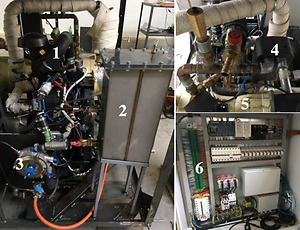Current issue
Online first
Archive
About the Journal
Aims and scope
Publisher and Editorial
Advertising policy
For Authors
Paper review procedures
Procedures protecting authentic authorship of papers
Paper preparation manual
Plagiarism check
Publication ethics
Reviewers
APC
Editorial and Scientific Board
Contact
Reviewers
The tests of micro-CHP prototype with SI engine powered by LPG and natural gas
1
Institute of Thermal Technology, Silesian University of Technology, Poland
2
Faculty of Energy and Environmental Engineering, Silesian University of Technology, Poland
Submission date: 2021-08-11
Final revision date: 2021-10-04
Acceptance date: 2021-10-07
Online publication date: 2021-10-12
Publication date: 2022-04-05
Corresponding author
Grzegorz Kazimierz Przybyła
Institute of Thermal Technology, Silesian University of Technology, Poland
Institute of Thermal Technology, Silesian University of Technology, Poland
Combustion Engines 2022,189(2), 47-53
KEYWORDS
TOPICS
ABSTRACT
This paper presents the experimental results of a Combined Heat and Power (CHP) prototype based on a SI V-twin internal combustion engine driving a synchronous generator. The paper presents the criteria that were used to select the combustion engine and the electrical generator for the prototype. The internal combustion engine has been adapted to be fuelled by natural gas or LPG, with the possibility of controlling the load in two ways, i.e. by changing the throttle position (quantitatively) and/or the value of the excess air ratio by changing the fuel dose at a constant throttle position (qualitatively). The applied method of control allows to improve the efficiency of the engine especially in the range of partial loads. The experimental tests were carried out at a constant speed of 1500 rpm. During the tests, the fuel consumption of the internal combustion engine, the composition of the exhaust gas at the outlet of the exhaust system, the electrical parameters of the synchronous generator and the temperature at selected locations of the CHP system instance were measured. According to the obtained results, there was a slight increase in the efficiency of electricity generation with the application of the developed method of control of the combustion engine. The maximum power generation efficiency for Natural Gas (NG) was higher compared to LPG by more than 2 percentage points.
REFERENCES (15)
1.
SUN, T., CHANG, Y., XIE, Z. et al. Experimental research on pumping losses and combustion performance in an unthrottled spark ignition engine. Proceedings of the Institution of Mechanical Engineers, Part A: Journal of Power and Energy. 2018, 232(7), 888-897. https://doi.org/10.1177/095765....
2.
VISHWANATHANA, G., SCULLEYA, J.P., FISCHERA, A. et al. Techno-economic analysis of high-efficiency natural-gas generators for residential combined heat and power. Applied Energy. 2018, 226, 1064-1075. https://doi.org/10.1016/j.apen....
3.
Vaillant and Honda present micro-combined heat and power system for home use. https://global.honda/newsroom/....
9.
TAIE, Z., HAGEN, C. Experimental thermodynamic first and second law analysis of a variable T output 1–4.5 kWe, ICE-driven, natural-gas fueled micro-CHP generator. Energy Conversion and Management. 2019, 180, 292-301. https://doi.org/10.1016/J.ENCO....
11.
KRYZIA, D., KUTA, M., MATUSZEWSKA, D. et al. Analysis of the potential for gas micro-cogeneration development in Poland using the Monte Carlo method. Energies. 2020, 13, 3140. https://doi.org/10.3390/en1312....
12.
Central Statistical Office. Energy consumption in households in 2018; Central Statistical Office of Poland: Warsaw 2019.
14.
PRZYBYŁA, G., RUTCZYK, B., ZIÓŁKOWSKI, Ł. Performance of micro CHP unit based on SI engine with quantitative-qualitative load control. Combustion Engines. 2019, 178(3), 82-87. https://doi.org/10.19206/CE-20....
15.
NOCOŃ, A., NIESTRÓJ, R., KRUCZEK, G. et al. Simulation of micro co-generator transient states coupled with mathematical model of internal combustion engine. 2018 International Symposium on Electrical Machines (SME). 2018, 1-5. Andrychów, Poland. 10-13.06.2018. https://doi.org/10.1109/ISEM.2....
Share
RELATED ARTICLE
We process personal data collected when visiting the website. The function of obtaining information about users and their behavior is carried out by voluntarily entered information in forms and saving cookies in end devices. Data, including cookies, are used to provide services, improve the user experience and to analyze the traffic in accordance with the Privacy policy. Data are also collected and processed by Google Analytics tool (more).
You can change cookies settings in your browser. Restricted use of cookies in the browser configuration may affect some functionalities of the website.
You can change cookies settings in your browser. Restricted use of cookies in the browser configuration may affect some functionalities of the website.



